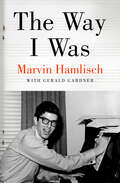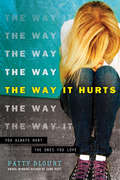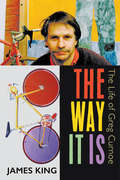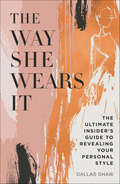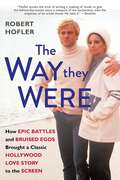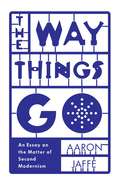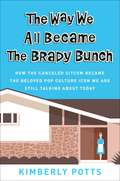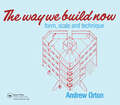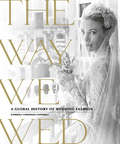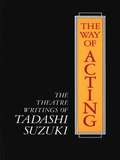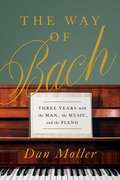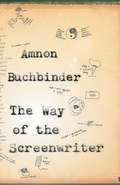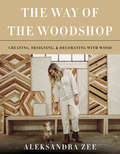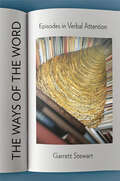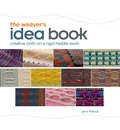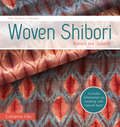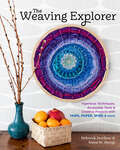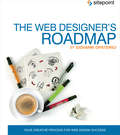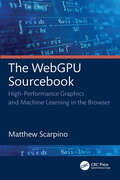- Table View
- List View
The Way I Was
by Marvin Hamlisch Gerald GardnerThe EGOT-winning composer of The Way We Were and A Chorus Line recounts his remarkable life from childhood to Broadway and Hollywood. The son of Jewish Viennese immigrants, six-year-old Marvin Hamlisch&’s early musical talent and discipline led him to Julliard, where he studied for more than a decade. From there, Hamlisch got his start as a rehearsal pianist for Funny Girl starring Barbra Streisand. He went on to co-create the classic American musical A Chorus Line and wrote the Oscar Award–winning musical score for The Way We Were. Hamlisch is one of only a handful of people to achieve EGOT status—winning an Emmy, a Grammy, an Oscar, and a Tony. In this autobiography, Hamlisch tells the tale of his life and career, revealing personal stories of his childhood, his marriage, and his friendships with stars including Liza Minnelli, Groucho Marx, and others. It offers an intimate view of his life and a compelling portrait of Broadway and Hollywood through the second half of the twentieth century.
The Way It Hurts
by Patty BlountThere may be two sides to every story, but sometimes there's only one way to set things right...Music is Elijah's life. His band plays loud and hard, and he'll do anything to get them a big break. He needs that success to help take care of his sister, who has special needs. So he'd rather be practicing when his friends drag him to a musical in the next town...until the lead starts to sing.Kristen dreams of a career on stage like her grandmother's. She knows she needs an edge to get into a competitive theater program—and being the star in her high school musical isn't going to cut it. The applause and the attention only encourage her to work harder.Elijah can't take his eyes off of Kristen's performance, and his swooning face is captured on camera and posted with an out-of-context comment. It goes viral. Suddenly, Elijah and Kristen are in a new spotlight as the online backlash spins out of control. And the consequences are bigger than they both could have ever imagined because these threats don't stay online...they follow them into real life.
The Way It Is: The Life of Greg Curnoe
by James KingThe long-awaited biography of one of Canada’s most intriguing and beguiling artists. Do artists really thrive in big cities, or do they just learn to imitate New York? Is it a contradiction for an artist to be fiercely local and profoundly identified with international art movements? If the brilliant colourist and regionalist pioneer Greg Curnoe stood for any one thing, it was making trouble. An intriguing rebel throughout his life, he challenged ideas about what art should be, and pushed it in radical new directions — including away from Toronto, a city he rejected while succeeding masterfully in its galleries. His untimely death in 1992 cut short a career of constant reinvention. This first biography of Curnoe recaptures in vivid detail the public and personal life of an iconoclast who was called a “walking autobiography,” as his work seemed to document his endless struggle against many of the core tenets of the art of his time. An anti-establishment firebrand and a fierce opponent of American dominance in Canadian culture, Curnoe, in his conceptual practice, constructed a stunning body of work that remains a hallmark in late-twentieth-century Canadian art.
The Way She Wears It: The Ultimate Insider's Guide to Revealing Your Personal Style
by Dallas ShawYou are your own brand. But to market yourself well, you need the best package, and that’s your own authentic style. In The Way She Wears It, fashion illustrator and It girl Dallas Shaw shows you how to mix up your closet and shop like a rock star.The most highly sought-after fashion illustrator/luxury project designer working today uses her sketches, styling skills and visual expertise to help you develop your eye, define your aesthetic, banish the predictable, stock your wardrobe, and make heads turn in this highly visual and lavishly designed & illustrated personal fashion guide.Working backstage, in showrooms, and alongside creative directors and iconic designers, Dallas learned from the best. In this sophisticated, illustrated handbook, this go-to girl for clients ranging from Chanel, Donna Karan, Oscar de la Renta, Kate Spade, Christian Louboutin, and Ralph Lauren to Anthropologie, Target, Maybelline, and Neutrogena shares her insider tricks—expert layering hacks, the secrets to print pairing, bold color choices—and something you won’t find off the rack: confidence.Organized around a range of challenges, this lookbook-meets workbook-is a must for every woman, whether you’re a fashion novice trying to figure out your signature style, a fashionista who wants to step up her game, or the most stylish presence in the room looking to stay ahead of the competition. Mixing breathtaking creative visuals—hundreds of photos and drawings, including 100 original pieces of art—and a little bit of girl talk,Dallas teaches every woman how to banish the predictable and develop and maintain their own unique look. She also busts fashion myths, serves up insider industry tricks and expert picks, and most important, inspires you to live beautifully.
The Way They Were: How Epic Battles and Bruised Egos Brought a Classic Hollywood Love Story to the Screen
by Robert HoflerThe first ever account of the making of the cinematic classic The Way We Were starring Barbara Streisand and Robert Redford, revealing the full story behind its genesis and continued controversies, its many deleted scenes, its much-anticipated but never-filmed sequel, and the real-life romance that inspired this groundbreaking love story… It&’s one of the greatest movie romances of all time. Fifty years on, the chemistry between Barbra Streisand as Jewish working-class firebrand Katie Morosky and Robert Redford as all-American golden boy Hubbell Gardiner remains potent. Yet the friction and controversy surrounding The Way We Were were so enormous, the movie was nearly never made at all. Impeccably researched and eye-opening, here is the full story behind the challenges, rivalries, and real-life romance surrounding the movie. Even the iconic casting was fraught. Screenwriter Arthur Laurents wrote the role of Katie with Streisand in mind, but finding Hubbell was another matter. Redford was reluctant to play what he perceived as the &“Ken doll&” to Streisand&’s lead, resulting in ten writers—among them Francis Ford Coppola—being called in to rework the script. The first preview was disastrous. Several scenes were cut, angering Streisand and Laurents, yet the new version was a resounding success, and its appeal endures, earning it a regular spot in the AFI&’s annual Top 10 movie romances.The Way They Were also explores the deep, surprising love story that inspired the screenplay—the relationship between Laurents, a Jewish Brooklyn-born college leftist, and his longtime partner, Tom Hatcher. Drawing on Laurents&’s unpublished writings, as well as interviews with Streisand, Redford, and other key players, this is the definitive account of a film that changed the rules of moviemaking and has defined romance ever since.
The Way Things Go: An Essay on the Matter of Second Modernism
by Aaron JaffeBuffed up to a metallic shine; loose fitting, lopsided, or kludgy; getting in the way or getting lost; collapsing in an explosion of dust caught on the warehouse CCTV. Modern things are going their own ways, and this book attempts to follow them. A course of thought about their comings and goings and cascading side effects, The Way Things Go offers a thesis demonstrated via a century-long countdown of stuff. Modernist critical theory and aesthetic method, it argues, are bound up with the inhuman fate of things as novelty becoming waste. Things are seldom at rest. Far more often they are going their own ways, entering and exiting our zones of attention, interest, and affection. Aaron Jaffe is concerned less with a humanist story of such things—offering anthropomorphizing narratives about recouping the items we use—as he is with the seemingly inscrutable, inhuman capacities of things for coarticulation and coherence. He examines the tension between this inscrutability on the one hand, and the ways things seem ready-made for understanding on the other hand, by means of exposition, thing-and-word-play, conceptual art, essayism, autopoesis, and prop comedy.Among other novelties and detritus, The Way Things Go delves into books, can openers, roller skates, fat, felt, soap, joy buzzers, hobbyhorses, felt erasers, sleds, magic rabbits, and urinals. But it stands apart from the recent flood of thing-talk, rebuking the romantic tendencies caught up in the pathetic nature of debris defining the conversation. Jaffe demonstrates that literary criticism is the one mode of analysis that can unpack the many things that, at first glance, seem so nonliterary.
The Way We All Became The Brady Bunch: How the Canceled Sitcom Became the Beloved Pop Culture Icon We Are Still Talking About Today
by Kimberly PottsIn celebration of the Brady Bunch's 50th anniversary, TV writer Kimberly Potts writes a Seinfeldia-like definitive history of the show that changed the family sitcom and made an indelible impact on pop culture.There isn't a person in this country who hasn't heard of The Brady Bunch. Whether it's the show they watched growing up, or the one their parents did--whether adored, or great to poke fun at--The Brady Bunch is unarguably one of the most enduring and inspiring TV shows of our time. It's lived a dozen lives, from its original comedy debut and big-screen movies, to the Emmy-winning TV auteurs it has inspired--everyone from Vince Gilligan to Jill Soloway--and promises to live many more. In The Way We All Became the Brady Bunch, TV and pop culture writer Kimberly Potts will draw upon her deep knowledge of and appreciation for The Brady Bunch and television and pop culture history, as well as her contacts, connections, and experience, to provide an industry insider narrative of The Brady Bunch. With fresh interviews, The Way We All Became the Brady Bunch will examine the show's lasting effects on its audience and take readers behind-the-scenes and into the lives of our most beloved characters, all to document why The Brady Bunch was one of the most groundbreaking shows of its time--and why it remains to this day, unforgettable.
The Way We Build Now: Form, Scale and Technique
by Andrew OrtonThis book examines the structural and construction design of buildings. The first part presents an overview of materials and structural forms taking the point of view of the designer, architect and engineer. The second part is an extensive examination of over 70 case studies. They have been carefully selected and tightly structured to present a summary of established modern methods of building construction. It contains copious ready-reference charts of design information, numerous photographs and meticulous axonometric drawings. The book is international in scope. Dual units are used throughout (SI and Imperial) and nearly half the case studies are taken from the USA. Cases are also drawn from Canada, Europe, Africa, Malaysia, Hong Kong as well as 25 from the UK.
The Way We Wed: A Global History of Wedding Fashion
by Kimberly Chrisman-CampbellFor fashion buffs, romantics, and brides-to-be, a fascinating collection of wedding garb and glamour through pop culture and history.The Way We Wed: A History of Wedding Fashion presents styles and stories from the Renaissance to the present day, chronicling evolving fashions, classes, and expectations. And because all wedding attire has a tale to tell, The Way We Wed also reveals fascinating personal stories of those who wore it.While the book is a rich source of bridal inspiration for all seasons, it's far from a monotonous parade of white gowns. The Way We Wed showcases wedding gowns of all colors and styles from around the world, as well as going-away dresses, accessories (shoes, veils, hats, and tiaras), and clothes worn by flower girls, bridesmaids, mothers of the bride, and grooms. Same-sex weddings are represented along with royal weddings, wartime brides, White House weddings, remarriage, Hollywood weddings, and more. The book features celebrity and historical couples as well as everyday people. A few of the included names:Angelina JolieFrida KahloElizabeth TaylorPrincess DianaMartha WashingtonSolange KnowlesEllen DeGeneresMeghan MarkleIllustrated with 100 gorgeous photos, The Way We Wed is a rich celebration of the art of wedding fashion across time and cultures, and those whose style and circumstances made a statement.
The Way of Acting
by J. Thomas Rimer Tadashi SuzukiThe most influential contemporary theatre director in Japan, Suzuki provides a thorough and accesible formulation of his ideas and beliefs, and insights into his training methods. Features his compelling adaptation of Clytemnestra--finding an astonishing parallel between ancient Greek and modern Japanese society, Suzuki melds traditional and avant-garde techinques to shed new light on this primal tale.
The Way of Bach: Three Years with the Man, the Music, and the Piano
by Dan MollerA tale of passion and obsession from a philosophy professor who learns to play Bach on the piano as an adult.Dan Moller grew up listening to heavy metal in teh Boston suburbs. But one day, something shifted when he dug out his mother's record of The Art of the Fugue, inexplicably wedged between ABBA's greatest hits and Kenny Rogers. Moller was fixated on Bach ever since. In The Way of Bach, he draws us into fresh and often improbably hilarious things about Bach and his music. Did you know the Goldberg Variations contain a song about his mom cooking too much cabbage? Just what is so special about Bach&’s music? Why does it continue to resonate even today? What can modern Americans—steeped in pop culture—can learn from European craftsmanship? And, because it is Bach, why do some people see a connection between music and God? By turn witty and though-provoking, Moller infuses The Way of Bach with philosophical considerations about how music and art enable us to contemplate life's biggest questions.
The Way of the Brush
by Fritz Van BriessenThe first paperback edition of this backlist classic, The Way of the Brush examines the technique, style, traditions, and methods of ink-painting. Illustrated with over 250 paintings and packed with instructions, The Way of the Brush covers every aspect of the art, from brushstrokes, composition, and the painting surface to meaning, perspective, and artistic philosophy. Part One explains the elements, techniques, and principles of Chinese and Japanese painting, while Part Two is devoted to challenges associated with the art. Also included are three appendices and a full bibliography.
The Way of the Brush
by Fritz Van BriessenThe first paperback edition of this backlist classic, The Way of the Brush examines the technique, style, traditions, and methods of ink-painting. Illustrated with over 250 paintings and packed with instructions, The Way of the Brush covers every aspect of the art, from brushstrokes, composition, and the painting surface to meaning, perspective, and artistic philosophy. Part One explains the elements, techniques, and principles of Chinese and Japanese painting, while Part Two is devoted to challenges associated with the art. Also included are three appendices and a full bibliography.
The Way of the Screenwriter
by Amnon BuchbinderA story is a living thing. And you don't work on a living thing, you work with it. This is the way of the screenwriter, and it is something that writer and director Amnon Buchbinder believes all masterful screenwriters understand intuitively: learning how to work with story through a painstaking process of trial, error, and self exploration. Amnon Buchbinder draws on his knowledge as a teacher and his experience as a script doctor and a story editor to explore this creative process. Along the way he illustrates principles often inspired by the philosophy of Laozi (Lao Tze) with examples drawn from major motion pictures such as Memento and The Piano. For the beginning or seasoned screenwriter who aspires to more than mere competence, Buchbinder illuminates a path towards mastery of the craft. For the lover of the cinematic experience, he opens a curtain to reveal a rarely seen world behind the big screen.
The Way of the Woodshop: Creating, Designing & Decorating with Wood
by Aleksandra ZeeShop Class as Soulcraft meets Norwegian Wood in this gorgeously illustrated DIY guide for aspiring woodworkers of all levels.“There’s just something about wood. It’s an imperfect material with cracks, knots, and irregularities. As an imperfect being, I find that by working with wood and all its inconsistencies, I can also tackle my own.” –Aleksandra ZeeRoll up your sleeves and get ready to master the basics of woodworking in Aleksandra Zee’s cozy Bay Area studio. The Way of the Woodshop is a meditative guidebook and a feast for the eyes, an illustrated journey through the joys of working, decorating, and crafting with wood. Packed with gorgeous photography and do-it-yourself projects ranging from easy to advanced, The Way of the Woodshop takes you step by step through the process of creating nesting cutting boards, a blanket ladder, a daybed, a table and bench, and more. Zee covers the basics, from choosing the right lumber, to understanding different wood types and grains, to curating a tool collection, along with tips on decorating with wood and curating a space that you love. Along the way, she encourages you to tap into your creativity and relish the joys of working with your hands, and she shares lessons from her own empowering journey, as a woman carving out her space in a stereotypically male profession.Whether you want to decorate your home, create personal gifts, or just love handmade objects, The Way of the Woodshop will inspire you to grab a sander and discover the joy of making!
The Ways of the Word: Episodes in Verbal Attention
by Garrett StewartIn The Ways of the Word, Garrett Stewart steps aside from theory to focus on the sheer pleasure of attentive reading and the excitement of recognizing the play of syllables and words upon which the best literary writing is founded. Emerging out of teaching creative writing and a broader effort to convene writers and critics, Stewart's "episodes in verbal attention" track the means to meaning through the byways of literary wording.Through close engagement with literary passages and poetic instances whose imaginative demands are their own reward, Stewart gathers exhibits from dozens of authors: from Dickinson, Dickens, and DeLillo to Whitman, Woolf, and Colson Whitehead. In the process, idiom, tense, etymology, and other elements of expressive language and its phonetic wordplay are estranged and heard anew. The Ways of the Word fluidly and intuitively reveals a verbal alchemy that is as riveting as it is elusive and mysterious.
The Weaver's Companion
by Marilyn MurphyAll the basics of weaving are provided in this succinct handbook. Filled with definitions and illustrations, the book invites weavers to refer to it as they work.
The Weaver's Idea Book: Creative Cloth on a Rigid Heddle Loom
by Jane PatrickNew and experienced weavers alike are always on the lookout for new weave-structure patterns. The Weaver's Idea Book presents a wide variety of patterns for the simple rigid-heddle loom, accompanied by harness drafts for multishaft looms. The techniques include leno, Brooks bouquet, soumak, and embroidery on fabric. Each chapter contains weaving patterns along with swatches illustrating the techniques, accompanied by step-by-step photography.The book is arranged by structure or type of weave, from variations on plain weave to doubleweave. With traditional patterns from around the world, bands, and fabrics woven on two double heddles, The Weaver's Idea Book brings together a variety of ways to create exquisite cloth. Weaving tips and tricks help weavers at all levels achieve their textile dreams. In addition to pattern drafts, Jane offers project ideas that guide the reader through creating functional woven projects, from wearables to home decor.Weaving, especially on rigid-heddle looms, is enjoying a resurgence, and contemporary weavers are in need of a book to bridge the divide between basic books and complex text designed for advanced weavers with sophisticated tools. Celebrating the immense potential for creativity possible with the simplest of tools, The Weaver's Idea Book eBook opens new avenues for exploration on both the rigid-heddle and multishaft looms.
The Weaver's Studio - Woven Shibori: Revised and Updated (The\weaver's Studio Ser.)
by Catharine EllisRediscover Woven Shibori In this update of the classic Woven Shibori, master weaver Catharine Ellis teaches weavers of all skill levels how to create beautiful dyed woven cloth, using environmentally friendly natural dyes. Shibori is a traditional Japanese technique, in which a piece of cloth is shaped by folding, stitching, tying, or wrapping then dyed to create stunning color patterns. Ellis developed a method of weaving resist warp and weft threads directly into the cloth and shared her findings in her breakthrough book. Featuring all-new information on working with natural dyes and dozens of new photographs, this revised edition is an invaluable resource for weavers. It features:Techniques for incorporating shibori into two-shaft weaves, monk's belt, overshot, twills, laces, and other patternsGuidance and inspiration for creating your own woven shibori designsInstructions for preparing the fabric for dyeing and finishing the dyed clothRecipes for creating natural dyes from plants and insects to dye both plant and animal fibersSpecial effects for enhancing woven shibori, including layering colors, cross dyeing, felting, creating permanent pleats, and burning outWoven Shibori opens up a world of creative surface design possibilities for weavers and textile artists.
The Weaving Explorer: Ingenious Techniques, Accessible Tools & Creative Projects with Yarn, Paper, Wire & More
by Gwen W. Steege Deborah JarchowWeaving is a highly accessible craft — over, under is the basic technique — but the stumbling block for many would-be weavers has been the high cost of a commercial loom. The Weaving Explorer removes that barrier, inviting crafters and artists to try out an amazing range of techniques and creative projects that are achievable with a simple homemade loom, or no loom at all! Weavers Deborah Jarchow and Gwen W. Steege take inspiration from the world of folk weaving traditions, adding a contemporary spin by introducing an unexpected range of materials and home dec projects. From sturdy rag fabric grocery bags to freeform wire baskets, delicately woven thread bracelets to colorful woven rugs, crafters will delight in exploring the opportunities to make their own personal variations on these beautiful — and functional — creations. This publication conforms to the EPUB Accessibility specification at WCAG 2.0 Level AA.
The Web Collection Revealed Premium Edition: Adobe Dreamweaver CS6, Flash CS6, & Photoshop CS6
by Elizabeth Eisner Reding Sherry Bishop Jim ShumanYou can now maximize and integrate the design and development power of Adobe Creative Suite 6 with WEB COLLECTION REVEALED PREMIUM EDITION. This one of a kind text features Adobe Dreamweaver, Adobe Flash, and Adobe Photoshop in one resource, and provides practical experience with each software application through projects and learner-friendly tutorials. Also a full chapter on integration demonstrates how to move effortlessly from one application to another, while Power User Shortcuts and New Features icons point out key changes effective with the release of CS6. WEB COLLECTION REVEALED PREMIUM EDITION provides the information and practice you need to build professional-quality Websites, using all three of these Adobe applications! The Data Files used to complete the projects found in the book are now available online. For access information please refer to the directions available in the preface of the book.
The Web Collection Standard Edition: Revealed
by Sherry Bishop Jim Shuman Barbara WaxerThis comprehensive introductory book provides step-by-step instruction and in-depth explanation on three of today's most widely used Web design and development programs: Adobe Dreamweaver CS3, Adobe Flash CS3, and Adobe Fireworks CS3. Readers gain practical experience with the software as they work through end-of-chapter learning projects and step-by-step tutorials. An integration chapter demonstrates how to move from one application to the other while creating a Dreamweaver Web site that incorporates both Flash and Fireworks files. Full-color illustrations and a user-friendly design combine to create a solid learning experience that reveals how to master the latest features of these popular applications.
The Web Collection: Adobe Dreamweaver CS3, Flash CS3, and Fireworks CS3 Revealed
by Sherry Bishop James E. Shuman Barbara M. WaxerThis comprehensive introductory book provides step-by-step instruction and in-depth explanation on three of today's most widely used Web design and development programs: Adobe Dreamweaver CS3, Adobe Flash CS3, and Adobe Fireworks CS3. Readers gain practical experience with the software as they work through end-of-chapter learning projects and step-by-step tutorials. An integration chapter demonstrates how to move from one application to the other while creating a Dreamweaver Web site that incorporates both Flash and Fireworks files. Full-color illustrations and a user-friendly design combine to create a solid learning experience that reveals how to master the latest features of these popular applications.
The Web Designer's Roadmap: Your Creative Process for Web Design Success
by Giovanni DiFetericiThe Web Designer's Roadmap is a full-color book about the creative process and the underlying principles that govern that process. While other books cover the nuts 'n' bolts of how to design the elements that make up websites, this book outlines how effective designers go about their work, illustrating the complete creative process from start to finish. As well as how-to content, the book draws on interviews with a host of well-known design gurus, including Shaun Inman, Daniel Burka, Meagan Fisher, Donald Norman and Dan Rubin. A non-academic book, this is a fun and easy read packed with practical information.
The WebGPU Sourcebook: High-Performance Graphics and Machine Learning in the Browser
by Matthew ScarpinoThe WebGPU Sourcebook: High-Performance Graphics and Machine Learning in the Browser explains how to code web applications that access the client’s graphics processor unit, or GPU. This makes it possible to render graphics in a browser at high speed and perform computationally intensive tasks such as machine learning. By taking advantage of WebGPU, web developers can harness the same performance available to desktop developers.The first part of the book introduces WebGPU at a high level, without graphics theory or heavy math. The chapters in the second part are focused on graphical rendering and the rest of the book focuses on compute shaders.This book walks through several examples of WebGPU usage. It also: Discusses the classes and functions defined in the WebGPU API and shows how they’re used in practice Explains the theory of graphical rendering and shows how to implement rendering inside a web application Examines the theory of neural networks (machine learning) and shows how to create a web application that trains and executes a neural network
